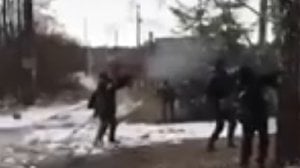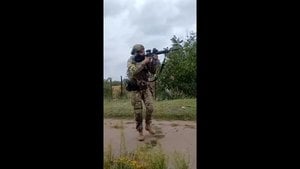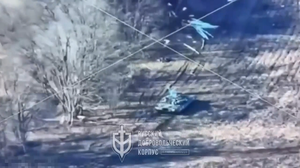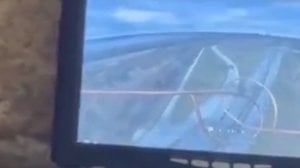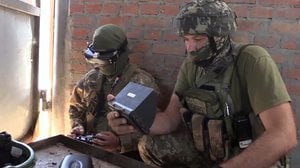
UA Soldier Shoots at FPV Drone
Published 1 years ago
A short video taken in Zaporizhia of a Ukrainian soldier destroying a Russian FPV drone with his rifle. The drone can be heard as the soldier pops up in his trench and engages the drone with his rifle. He tracks the target and fires over the head of a comrade taking cover in the trench. The drone explodes above and behind the other soldier, probably contributing to some emotional discomfort.
Though brief, this video demonstrates the unique challenge created by drones on the modern battlefield. In Ukraine we see both sides employing a variety of systems in specialized roles. Some drones are employed for reconnaissance purposes; larger UAVs with more fuel, more time on station, and, in some cases, specialized sensors, which can feed information to commanders and provide targeting data for long-range precision fires, while smaller platforms, including off-the-shelf quadcopters, can serve in a reconnaissance and forward observation role for at the battalion level and below. Bother larger, fixed-wing systems and smaller quadcopters can be configured to deliver fires, from missiles to dropped munitions such as mortar rounds and grenades. And finally, some loitering munitions and quadcopters can be configured as munitions themselves. These kamikaze drones, or FPV drones, are flown into or near a target by the operator, at which point they detonate. Often loitering munitions are employed in swarms, observed and directed by the operator of a reconnaissance drone, who can vector FPV drones against a single target or multiple targets, and then can observe the effects of the strike. This video provides an example of the latter.
Drones complicate the already complex battlefield geometry of conventional warfare. Until recently, warfighters have contended with direct and indirect fires. Direct fires, from rifles and machine guns, have been dealt with by the use of cover, advancements in armor, and by gaining and maintaining fire superiority, both direct and indirect. When combat troops react to direct fire systems by finding defilade and seeking cover, they are engaged with mortars, artillery, and MLRS platforms, which are countered by the construction of field fortifications with overhead cover, counter-battery fires, and aviation. Getting shot at with machine guns sucks, but fighting positions, stoutly constructed buildings, micro-terrain, sandbags, armored vehicles, and a variety of other solid objects can provide some protection. Getting hit with mortars and artillery also sucks, but slit trenches, fighting positions with thick overhead cover, pillboxes, stoutly built buildings with cellars, etc. can all offer some protection. Sensible warfighting involves advancing one’s troops to the objective while minimizing their exposure to direct and indirect systems, and by using friendly aviation and IDF assets to minimize effective fires coming from the other side of the battlefield.
Drones have complicated this geometry. Older, larger systems, such as the American Predator or the Turkish TB2 Bayraktar operated as similar rules as aircraft. They were given airspace and their fires directed by an observer, wither ground based or in the air. Predators were able to launch Hellfire missiles with impunity because they operated in places like Afghanistan or Iraq, where enemy air defenses were minimal. In the early days of the Ukraine conflict, the TB2 was able to exploit disorganized Russian air defenses to pick apart armored columns attempting to advance towards Kyiv. Once Russia sorted out its air defense and airspace deconfliction issues, the TB2 played much less of a role in Ukrainian operations. Smaller, cheaper, and more readily available drones were pressed into service to fill the gap in Ukrainian aviation capabilities and have since evolved into the systems we see today.
The issue raised in this video is one that the Funker team, and Josh and I in particular, have discussed as of late, and that is how will western organizations such as the USMC integrate these capabilities, and how can they defend against the systems and tactics we have witnessed in Ukraine. That latter point is of particular concern, and western forces seem slow to wargame and implement solutions to the threat posed by small drones. Our grandfathers (or great-fathers) who served in World War II, particularly in North Africa and Italy, faced attacks by Luftwaffe marauders, and both passive and active measures were adapted to face the threat. Units assigned air-sentries to scan the skies; soldiers dug slit trenches several meters away from their vehicles when halted for more that five minutes; camouflage netting and other concealment techniques were employed; units moved from assembly areas to assault positions at night to hide from airborne observers. Active measures included the use of flak guns, radar-directed air-defense artillery, and smaller anti-aircraft guns deployed at the small unit level. Over the years, many of the active concepts persisted and evolved, with specialized missile batteries dedicated for high-speed or high-altitude threats while a combination of missile and gun systems developed for slower, low altitude threats, such as Avenger, Gepard, the LAV-AD, ZSU-23-4, and shoulder-fired SAMs, though some of these were seen as obsolete in an era of high-speed jets and missiles and were sent out to pasture. Assets like C-RAM have been adapted from a maritime point defense role to protect FOBs from mortar shells and rockets, while Israel’s Iron dome was developed to intercept cheap Hamas rockets.
The new generation of drones, both FPV drones, and quadcopters dropping grenades and mortars, has placed the issue of anti-air defense back into the forefront, and western militaries find themselves woefully unprepared. Drone-dropped munitions can negate the benefit of defilade or simple trenches and fighting positions, while FPV drones can fly into protected structures with overhead cover, targeting HQ and C2 nodes. They are cheap and plentiful, and place enormous cost burden on a defender using conventional systems. States simply, using a $60,000 missile to destroy a $5,000 drone is not a good trade, particularly when missiles and operators are in shore supply, but drones are plentiful. I would like to see organizations like the USMC integrate passive measures into training, including old methods such as air sentries, camouflage and concealment, night movement. Simple protective measures like overhead protection, from timber to chicken wire, and netting can provide enhanced protection to defensive positions. New technologies such as thermal blanketing can provide concealment from thermal sensors.
As for active measures, I fear that this is one facet of anti-air and anti-drone defense that may be left unattended until it is too late. I have discussed the issue with some colleagues who are still in uniform who see lasers, directed energy, and jamming as the answer to cheap, off the shelf drones, but I do not think that laser systems have yet been proven, and can not be distributed in sufficient numbers to offer protection to every rifle company, every tank platoon, every mortar platoon, every artillery battery, and every LOGPAC, resupply convoy, or forward resupply point. Reliance on missile-based systems is not the answer, as drones are too plentiful for our stockpile and missiles are an expensive bullet to fire at a cheap target. The short to mid-term answer is in a gun-based platform that with a high rate of fire, which can be resupplied cheaply and easily, which can rapidly shift from target to target, which can be fielded at the company and platoon level, and on which soldiers and Marines can be easily trained. Could lasers work? We don’t know, maybe. Would directed energy weapons work? Maybe. Jamming? Maybe, for a while. Do we know how to combine a radar and a gatling gun? We absolutely know how to do that, and it absolutely can blow things out of the sky. The LAV-AD, which the Marine Corps discarded twenty years ago, sported stinger missiles and 25mm gatling gun, and would have been a great off the shelf example, but an even smaller option that can be mounted on a JLTV and which fires 7.62 or .50 caliber might be better suited to the current threat.
The most significant changes that must occur are in individual and small-unit training and in organizational mindset. For two decades the USMC and US Army have operated in environments with minimal air threats, and troops designated for those tasks have found themselves securing forward operating bases, performing convoy escort duties, or being sent off as individual augments to CENTCOM or AFRICOM. Now that the world has seen drone warfare evolve in real time and has witnessed cheap drones eviscerate a large conventional army, every major power, every second or third-tier military, every parasitic non-state actor (like Hezbollah), will integrate these systems and the associated TTPs, with the goal of nullifying western advantages in technology, firepower, and resources. Unlike the IED threat, the U.S. and its allies has an opportunity to counter this threat before our soldiers pay the price, rather than waiting for coffin-draped flags and maimed young men and women to be the catalyst for change.
About the Author

Cam
Cam served as an infantry officer in the Marine Corps, deploying to the Horn of Africa and participating in combat operations in Iraq. He currently works in the maritime industry and in the defense sector as an instructor of combined arms planning and operations. An avid sailor, Cam founded and directs Triumph Sailing, a nonprofit that supports veterans and first responders through adventure and fellowship on the water. Triumph Sailing is preparing for its big yearly event, an offshore race in the Gulf of Mexico with an all veteran crew. You can support the mission at Tri-Sail.Org.



